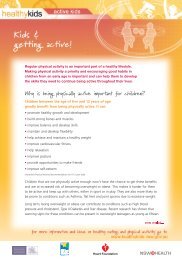The Physical Activity Handbook - Good For Kids
The Physical Activity Handbook - Good For Kids
The Physical Activity Handbook - Good For Kids
Create successful ePaper yourself
Turn your PDF publications into a flip-book with our unique Google optimized e-Paper software.
P.2<br />
I Move We Move Every Day<br />
<strong>The</strong> activities described in Tables 1– 6 can be offered opportunistically throughout the day to<br />
support active play and promote physical activity every day.<br />
Table 1: Everyday activities for preschoolers that promote<br />
physical activity, especially the development of fundamental<br />
movement skills 34<br />
Stability skills<br />
Balancing<br />
• Big wooden blocks can be used for stepping and balancing on or jumping off, as they are low<br />
to the ground<br />
• Simple yoga, pilates or tai chi exercises can encourage children to balance in a variety of ways<br />
• Create balance challenges using hoops or carpet squares. Ask children to balance inside or outside<br />
the object (i.e. half their body inside the object and half outside) – see Table 6<br />
• Hula hoops can be good to practice balancing whilst twisting<br />
• String, streamers, tape, chalk lines or rope can be placed on the floor in different patterns.<br />
Children can be encouraged to move along them in a variety of ways. <strong>The</strong> children can help<br />
design the patterns<br />
• Create an obstacle course – see Table 6<br />
• Practice static balance positions, such as:<br />
• Place both hands and feet on the floor with body raised off the ground<br />
• Same position as above but with one leg raised<br />
• Raise one arm off the ground and keep both feet on the floor<br />
• Sit with legs out in front, and hands behind for support<br />
• Sit as previously suggested, but with arms extended outwards (repeat with arms<br />
extended upwards)<br />
• Sit with knees bent and arms behind for support<br />
• Sit with knees bent and arms extended outwards<br />
• Sit with both legs and arms off the ground, and arms extended outwards<br />
• Sit with arms behind back, and raise both legs<br />
• Repeat with only one leg raised and the other leg bent with your foot on the ground<br />
• Lie on back using arms for support and raise one leg<br />
• Lie on back, put arms and legs on the floor to make a bridge shape. Do not arch the back<br />
• Help older children explore balance by simply asking them to show you a position, then tell<br />
you how they can extend it e.g. raise one leg<br />
I Move We Move, <strong>The</strong> <strong>Physical</strong> Acitivity <strong>Handbook</strong> – Preschoolers, Edition 1 August 2009<br />
AREA HEALTH SERVICE<br />
P.2




